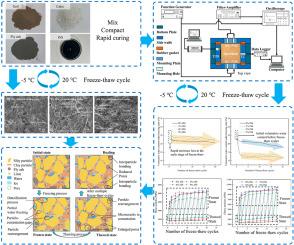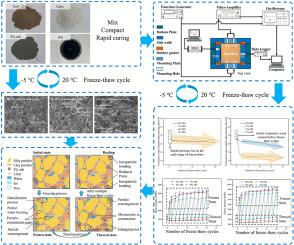Non-destructive evaluation of freeze-thaw performance in ISS-lime-fly ash stabilized saline soils
IF 10
1区 环境科学与生态学
Q1 ENGINEERING, ENVIRONMENTAL
引用次数: 0
Abstract
Replacing conventional cement-based binders with cleaner materials for soil stabilization has become a research priority due to the pressing need to reduce carbon emissions in the construction sector. This study explores a sustainable stabilization method using ionic soil stabilizer (ISS), lime, and fly ash to improve the freeze-thaw durability of saline soils, which pose serious challenges to infrastructure in cold regions. A series of non-destructive testing methods, including elastic wave velocity measurements (S-wave and P-wave), time-domain reflectometry for volumetric water content analysis, and scanning electron microscopy, were employed to assess soil stabilization efficiency. The results indicate that ISS-lime-fly ash stabilization significantly enhances the freeze-thaw resistance of saline soils by promoting aggregate formation, improving cementitious bonding, and reducing the temperature sensitivity of water content in the frozen state. The evolution of S-wave and P-wave velocities revealed that ISS-lime-fly ash treated specimens exhibited greater structural integrity and slower degradation in mechanical properties compared to lime-fly ash treated soils. After 20 freeze-thaw cycles, the thawed ISS-lime-fly ash stabilized soils exhibited shear modulus values ranging from 1055 to 1325 MPa and small-strain Young's modulus values from 2973 to 3644 MPa. Integrating microstructural observations with existing research, this study elucidates freeze-thaw damage and self-healing mechanisms in stabilized soils while revealing the influence of ISS content on freeze-thaw behavior. These findings support the development of low-carbon soil materials for sustainable construction in cold and saline regions.


iss -石灰-粉煤灰稳定盐渍土冻融性能的无损评价
由于迫切需要减少建筑行业的碳排放,用更清洁的材料取代传统的水泥基粘合剂来稳定土壤已经成为研究的重点。本研究探索了一种使用离子土壤稳定剂(ISS)、石灰和粉煤灰的可持续稳定方法,以提高寒冷地区对基础设施构成严重挑战的盐渍土的冻融耐久性。采用弹性波速测量(横波和纵波)、时域反射法(体积含水量分析)和扫描电镜等一系列无损检测方法评估土壤稳定效率。结果表明,iss -石灰-粉煤灰稳定剂通过促进骨料形成、改善胶凝结合、降低冻结状态下含水量的温度敏感性,显著提高了盐渍土的抗冻融能力。横波和纵波速度的演化表明,iss -石灰-粉煤灰处理过的土具有更好的结构完整性和更慢的力学性能退化。经过20次冻融循环后,解冻后的isl -石灰-粉煤灰稳定土的剪切模量为1055 ~ 1325 MPa,小应变杨氏模量为2973 ~ 3644 MPa。本研究结合微观结构观察和已有研究,阐明了稳定土冻融损伤和自愈机制,揭示了ISS含量对冻融行为的影响。这些发现支持了低碳土壤材料的开发,用于寒冷和盐碱地的可持续建筑。
本文章由计算机程序翻译,如有差异,请以英文原文为准。
求助全文
约1分钟内获得全文
求助全文
来源期刊

Journal of Cleaner Production
环境科学-工程:环境
CiteScore
20.40
自引率
9.00%
发文量
4720
审稿时长
111 days
期刊介绍:
The Journal of Cleaner Production is an international, transdisciplinary journal that addresses and discusses theoretical and practical Cleaner Production, Environmental, and Sustainability issues. It aims to help societies become more sustainable by focusing on the concept of 'Cleaner Production', which aims at preventing waste production and increasing efficiencies in energy, water, resources, and human capital use. The journal serves as a platform for corporations, governments, education institutions, regions, and societies to engage in discussions and research related to Cleaner Production, environmental, and sustainability practices.
 求助内容:
求助内容: 应助结果提醒方式:
应助结果提醒方式:


